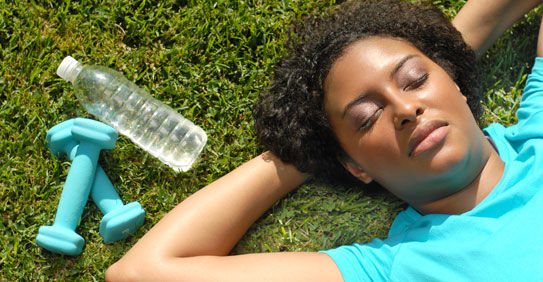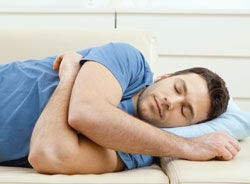
By JIM GERARD
As a fitness professional, you’re used to informing your clients on ways to attain optimum performance—workout techniques, proper form, healthy nutrition and supplementation. But you also might want to take a tip from NBA and NHL players such as LeBron James and Patrick Elias, who take “power naps” on game days to help recover from the rigors of a grueling schedule and who swear by their restorative effects.
Dr. Cheri Mah, a researcher at the Stanford Sleep Disorders Clinic and Research Laboratory, told The New York Times, “Many athletes have optimized physical training and nutrition…but there really hasn’t been the same emphasis on optimizing sleep and recovery.”
That’s where power nap length can play a crucial role, an idea that is gaining acceptance around the NBA, at the instigation of Dr. Charles Czeisler, the director of the Division of Sleep Medicine at Harvard Medical School. Czeisler, known in the NBA as the sleep doctor, is educating teams such as the Boston Celtics on the performance benefits of naps.
Czeisler spoke to ACE about the numerous athletic advantages of naps. First, sleep in general, and nap sleep in particular, help to consolidate memory, especially for newly acquired skills, which Czeisler said was proven in studies involving animals and mazes. “What happens is that certain brain cells fire when they hit certain points in the maze. We’ve found that the mice are rerunning the maze in their sleep and when they awaken, they can more quickly negotiate the maze. The animals were ‘practicing’ during sleep.”
Dr. Peter Walters, associate professor in the applied health science department at Wheaton College in Wheaton, Ill., says that there is conclusive evidence of a correlation between sufficient sleep and mental acuity, especially logical and critical thinking. He cites a study of subjects between 21 and 61 years old, conducted by Dr. Catherine Milner at Brock University in Ontario. “Napping led to improvements for all age groups in subjective sleepiness, fatigue and accuracy on a serial addition/subtraction task,” Milner reported. “The participants were more physiologically alert following naps.”
Furthermore, sleep improves reaction time, as proven by a series of Stanford University studies in which basketball and tennis players and swimmers had their sleep extended to 10 hours a day (which, says Czeisler, is what most pro athletes need). After a few weeks, the hoopsters’ free throws were more accurate, the swimmers bettered their sprint times and the tennis players got more of their first serves in. Conversely, if nightly sleep is reduced by a couple of hours, instead of an athlete taking a quarter-second to respond to stimulus it takes a third or half a second—the difference between making and blowing the play.
A Cure for Crankiness, A Boost for Immunity

Mood stabilization is another benefit of napping. Czeisler describes a scenario of the sleep-deprived basketball player: “If a ref calls a bad foul, the player might flip out and get a technical foul or even thrown out of the game. He may also have more difficulty working cohesively with his teammates. He may think, ‘Hey, this guy didn’t throw me the ball at a key time.’” Czeisler says that brain studies with magnets reveal that in the sleep-deprived, the amigdyla—the part of the brain that controls emotional stability—fires more quickly.
A third benefit of sleep—including napping—is its capacity to control inflammation and thus speed recovery time from injury, to which we’re more susceptible when sleep-deprived. Sufficient sleep also boosts our immune system—Czeisler says that a sleep-deficient person may only get half the antibody response from a flu shot.
If those benefits weren’t enough, a proper amount of sleep also regulates carbohydrate craving, weight gain and blood pressure.
In addition, Walters states that skin cells multiply at a much greater rate during sleep, and that higher levels of human growth hormone are released during the deeper stages of sleep. “If you regularly deprive somebody of sleep, especially during puberty, it will stunt their growth significantly.”
A Debt That Can Be Difficult to Pay Back
Walters speaks of a current term used by sleep-ologists: sleep debt, which is the amount of sleep we get that is below our natural quota. Most of us accumulate a 16-hour sleep debt during the day, which allows us to sleep throughout the night. “Say you need eight hours and you only get seven for an entire week—well, add it up and you’ve missed a night of sleep. If you’re an athlete and you’re incurring sleep debt, you’ll have trouble recovering.” Hence the need for naps.
Experts seem to agree that for the average person/weekend athlete, the optimum nap time is from 10 to 30 minutes. A study conducted by Dr. Amber Brooks at the School of Psychology at Flinders University in Adelaide, Australia, compared the benefits of different-length naps and concluded that while the five-minute nap resulted in no benefits, the 10-minute nap proved to be the most beneficial.
Napping much longer than this risks both immediate physiological impairment—that groggy feeling—upon awakening and jeopardizing your nighttime sleep.
To those who question whether naps are truly necessary, consider that they are established custom in many countries and that by most estimates, 60 percent to 70 percent of all Americans are sleep-deprived. (Dement claims that every subject studied at the Stanford Clinic has suffered from sleep deprivation, attributing this to the pressures of modern society and ignorance about the many types of sleep disorders, such as sleep apnea.)

What to Tell Your Clients About Sleep
- Don’t jerk your body clock around. Set up a regular time for sleep—get to bed at the same time each night, plus-or-minus 30 minutes. Make it part of your training routine. Don’t go to bed at 3 a.m. on weekends and 11 p.m. on weekdays, as it degrades sleep quality.
- Don’t underestimate the time you need for sleep. (For example, if you’re 20, you need nine to 10 hours.)
- Avoid alcohol and caffeine; they interfere with sleep.
- Remove all gadgets—televisions, CD/DVD players and cell phones—from the bedroom. “You should be winding down with a magazine,” Czeisler says. “Turn off the cell phone—one out of 10 kids is saying their sleep is interrupted by text messages. This, or having the TV or CD player on, produces incredibly inefficient sleep.”
- Minimize sound and light exposure in the hour prior to sleep.
- Create an environment conducive to sleep—a dark, quiet place with minimal interruptions.
- If you’re traveling to a different time zone, don’t nap when you arrive at your destination. Stay up and get into the rhythm of the new day.
- If you work unconventional hours, such as the night shift, take an evening nap.
- Listen to your body by going to sleep and noting how long you slept without artificial interruption (the alarm clock).
- For coaches and trainers of athletes playing team sports: Adjust the start times of practices. If you have a day off, stay in one city instead of flying out after the game. Considering screening your athletes for sleep disorders to find out who might be at risk.
Many Unanswered Questions Remain
One should note that the science of sleep is still in its formative stages, and many questions remain. “A lot more research needs to be done; all kinds of performance needs to be studied,” says Dr. Bill Dement, professor of sleep disorders medicine at Stanford University Medical School. In fact, Dement, who has discovered only that extra nighttime sleep improves athletic performance, questioned the scientific validity of the testimonies of pro athletes regarding the advantages of naps. “There may be short-term revitalization that isn’t well studied, but there also may be impairment. You pay back your sleep debt over time, not overnight. Some people may find naps beneficial while others don’t.”
According to Walters, “There’s no study that has taken fully rested people, given them naps and asked how they function.”
Walters adds a caveat: Not everyone should nap. “If you have trouble taking naps, don’t do it,” he advises. “If you have trouble sleeping and taking naps, maybe you don’t need that much sleep. Although the average adult requires eight hours, we know that sleep is a lot like shoe size—it differs according to the individual.”
The same goes for naps. Dement says, “Each person needs to determine when and how long they need to nap. The best gauge of how much sleep you’re getting is how you feel in the daytime and how you feel after your nap.”
Walters feels that those doing moderate exercise probably don’t need extra sleep or napping. However, he cautioned that the sleep needs of marathon runners and others who push their bodies over long periods of time haven’t been subjected to scientific scrutiny. They may need to take an afternoon siesta.
__________________________________________________________________________

Jim Gerard is an author, journalist, playwright and stand-up comic. He has written for the New Republic, Travel & Leisure, Maxim, Cosmopolitan, Washington Post, Salon, Details, New York Observer and many other magazines. For more information, visit his site at www.gangof60.com